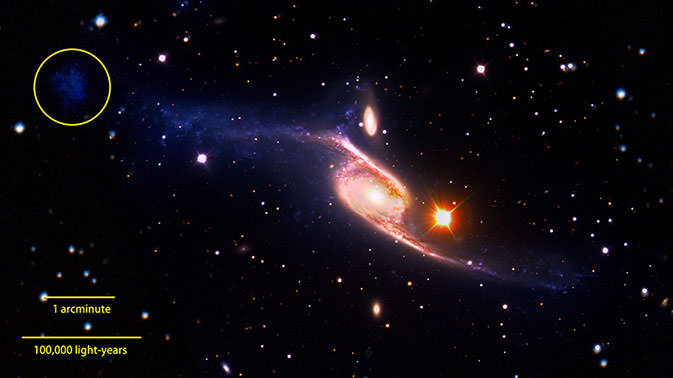Astronomers have long known that a spectacular barred spiral galaxy named NGC 6872 is a behemoth, but by compiling data from several space- and ground-based observatories and running a few computer simulations, they have now determined this is the largest spiral galaxy we know of.
Measuring tip-to-tip across its two outsized spiral arms, NGC 6872 spans more than 522,000 light-years, making it more than five times the size of our Milky Way galaxy.
"Without GALEX's ability to detect the ultraviolet light of the youngest, hottest stars, we would never have recognized the full extent of this intriguing system," said lead scientist Rafael Eufrasio, from the Goddard Space Flight Center the Catholic University of America in Washington. He presented the findings Thursday at the American Astronomical Society meeting in Long Beach, California.
But this galaxy didn't get so gargantuan all on its own. Astronomers think large galaxies, including our own, grew through mergers and acquisitions -- assembling over billions of years by absorbing numerous smaller systems.
The galaxy's unusual size and appearance stem from its interaction with a much smaller disk galaxy named IC 4970, which has only about one-fifth the mass of NGC 6872. The odd couple is located 212 million light-years from Earth in the southern constellation Pavo. Intriguingly, the gravitational interaction of NGC 6872 and IC 4970 may have done the opposite, spawning what may develop into a new small galaxy.
"The northeastern arm of NGC 6872 is the most disturbed and is rippling with star formation, but at its far end, visible only in the ultraviolet, is an object that appears to be a tidal dwarf galaxy similar to those seen in other interacting systems," said team member Duilia de Mello, a professor of astronomy at Catholic University.
The researchers used archived data from the Galaxy Evolution Explorer (GALEX) mission, and studied the galaxy across the spectrum using data from the European Southern Observatory's Very Large Telescope, the Two Micron All Sky Survey, and NASA's Spitzer Space Telescope.
Read the team's paper
Source:
NASA
 Universe Today
Universe Today
